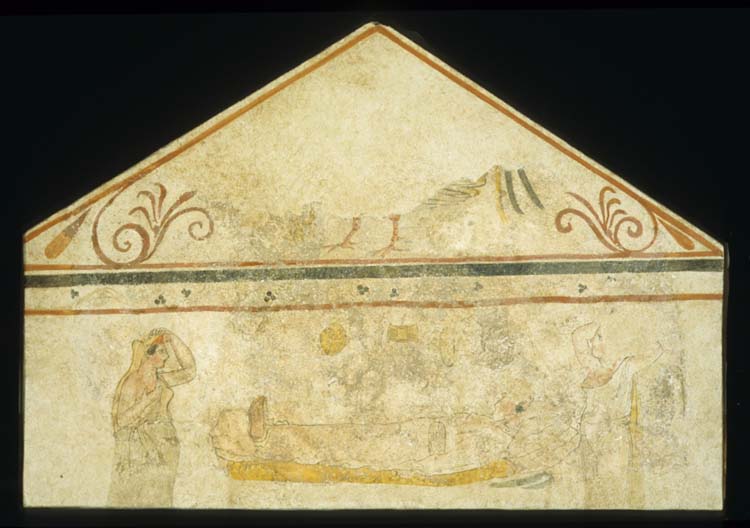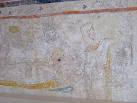

Unknown
Greek (active Paestum, southern Italy)
Tomb Painting, 4th c. BCE
Fresco on limestone
34 ¼ x 49 x 2 ¼ in.
SBMA, Gift of Sheri Kelts
1999.31
RESEARCH PAPER
The complex of well preserved Greek temples and the ruins of the city known as Paestrum is situated about a half mile from the present coastline of the Gulf of Salerno in Southern Italy. It was first settled by Achaean Greeks as part of the colony of Poseidonia in the late 7th or 6th century B.C.E. The nearby necropolis contains many painted tombs, which reflect the provincial artistic style of a colony some distance from the main centers of art and culture: figures are shown in profile, their features outlined in black with pale colors used in the flesh and garments and simplified decorative motifs. In many of the scenes such as this one, mourning figures, their arms raised in lamentation, surround the dead person.
The gabled end of a tomb from fourth century B.C.E. Poseidonia shows a woman on a bier with a woman mourning at either end of the couch. The mourners are doing the traditional lamentation of tearing out their hair. The mourner to the left seems to be beating and tearing at her breast. The figures are in profile with rosy complexions and red lips. Yellow scarves trail from the back of their heads. One has a little red visor over her forehead. The garments of the mourners are simple and of a thin fabric fastened at the left shoulder. The Dead woman is in a simple garment with a decorative belt. A band of yellow underlines her bier. There is s swirl of blue under this yellow line below her upper torso. Blue is often used to delineate textile couch covers. Dots were a design innovation on pottery from Poseidonia. Are the groups of three dots between the red and black bands on the top of the picture just designs?
Above the dead woman are three objects. The white egg, far right, represents fertility, and resurrection. This symbol was popular with Greeks, Lucanians, and Etruscans in funerary contexts. The gold objects should have some domestic connection. Are they related to weaving or farming? One looks like a ball of yarn the other a bundle of grain with a shoot coming from the container. Spinning weights were thought to be a good votive to present to a female deity when entering a temple.
At the top of the gable we can make out the feet and tail of a rooster. Plato suggests sacrificing a rooster when someone dies. In the angles of the triangle to each side of the rooster are stylized palmettos. These designs are typical of designs found on red figured ware of this time and place as is the drawing of the lamentation scene.
What scenes were on the other five slabs? What goods were in the grave? This we do not know. Poseidonia was known for wall frescoes although none have survived. From the tomb pieces and vase painting they must have been splendid.
This tomb piece came from the Greek colony of Poseidonia , which was twenty miles south of the Amalfi coast, fifty miles south of Naples and half a mile inland on the Gulf of Salerno. Achaean and Troizen Greeks who fled from another Greek colony, Sybaris, about 600 B.C.E., founded Poseidonia. Great religious fervor and architectural creativity produced three temples built in the sixth and fifth centuries B.C.E. The use of Doric and ionic columns preceded their use on the Parthenon by fifty years.
Poseidonia was one of the more important colonies of Magna Graecea, which extend from the coast of Turkey to the Greek Islands, to Sicily and southern Italy, to Marseilles, France. Greeks went west not just for trade and curiosity but also because of overpopulation, war, drought and a desire for land. They never wished to be separate from, nor dependent on their homeland. They drew on information and ideas learned in Greece, but as Greeks did everywhere, they transformed what they had learned.
At the northern end of Greek colonization in Italy, Poseidonia was in close contact with the Etruscans. At the end of a long land route, which allowed Greek goods to come from the south to avoid the long sea haul around the boot, there was contact with people from the interior of Italy. No written record of life in Poseidonia exists so material evidence such as graves, buildings, tools and pottery and other remains must be relied upon for information.
After two hundred years as a Greek City, the Lucanians took over. They were a Samnite people from the interior. They lasted about one hundred years, on and off, until Imperial Rome planted a Latin colony in 237 B.C.E. and changed its name to Paestum.
In the sixth century graves were cut in rock and covered with tiles or wood covered with tile. Bodies of infants were buried in amphorae in graves cut in rock. From the number of Amphorae found there was a high infant death rate. Graves were aligned in an east-west direction with the head in the east. The only luxury grave item was a perfume bottle. There was no social distinction in death, no vases, no weapons, and no jewelry. Sometimes broken pottery was found above the grave. Was pottery used as a grave marker or for a good-bye toast? “It is possible that graves of the wealthy have escaped discovery, that the simplicity and similarity of these graves is due, tritely enough, to poverty… On the other hand, perhaps the lack of grave goods reflects the societies’ egalitarian attitude which may be associated with the emergence of a democracy in Poseidonia”1
As the fifth century closed, Greeks kept a wary eye to their neighbors in the interior. About 400 B.C.E. the Lucanians invaded Poseidonia, which brought about a fusion of people and ideas. The language, government, and religion stayed the same, and the same coinage continued to be used. Two outstanding painters emerged, Asteas and Python, who painted Greek mythology and comedy, more theatrical than theater.
The fourth century B.C.E. brought a new style of grave goods. The tombs now had gable ends, two long sides and two slabs for the roof. The limestone slabs were coated with stucco and painted with earth colors in the artist’s studio. The painted slabs were inserted into the rectangular cut in the travertine as before with the same east-west orientation. On the gable end, the dead person is often depicted. If a man, ”he may be armed and sometimes on horse back which suggests he may be returning from the battle field…alternatively, he may be seen as embarking on a journey to the next world.”2 On the long sidewalls, funeral games are sometimes depicted: chariot races, boxing matches or armed combat, while others show the deceased on the bier surrounded by mourners. The shorter sides sometimes show mourning women gesturing extravagantly, as on the Santa Barbara piece, or funeral processions with sacrificial animals and mourners, musicians and children. The mourners may be carrying gifts of food and drink. “It seems to be the case that when the dead is shown prostrate on the bier or deathbed (on the gabled end), it is a woman; but that men appear in more heroic circumstances.” Sometimes Charon the helmsman over the river Styx is depicted ferrying a passenger to the next world.
With the arrival of the Lucanians, goods were now being placed in graves. A man’s tomb could contain weapons, armor of various sorts, painted vases particularly the krater, which was the symbol of the masculine banquet, and the strigil, the emblem of athletics. A woman’s grave would contain numerous pieces of jewelry, fibulae of silver and bronze, bracelets and necklaces of amber, occasionally miniature objects representing fruit, bread, cheese and farm products, amphorae (storage jars), hydria (water jars), and the wedding bowl--everything relating to home, marriage, and symbols of the woman's world.
“In the final phase of Lucanian tomb painting (c. 330-c.290 B.C.E.) painters prefer larger scenes and larger figures: the tomb itself increases in size and becomes a chamber tomb allowing the artist to paint directly on the tomb wall.” With more space a tomb could be better endowed with goods, painted vases, weapons, armor, jewelry and occasionally mini terra cotta fruit and farm products. Ostentation and social stratification was the goal. In the fifth century the society’s democratic system was acknowledged; by the end of the fourth century, under the Lucanians, a new attitude towards the dead was introduced. Ostentation and social stratification was the goal. The social pyramid is sharpened and a few well-endowed families, an oligarch, emerge. Next come the Romans. Inhumation ends and cremation is the preferred method of burial.
Much is unknown and unclear about the rites for laying out the dead. Paestum was long neglected. Archeological studies continue. Perhaps new studies will bring more information.
CITATIONS
1 PEDLEY, J.G., Paestum, Greeks and Romans in Southern Italy, Thames and Hudson, N.Y. 1990
2 Ibid p. 102
3 Ibid p. 102, 104
4 Ibid p. 105
BIBLIOGRAPHY
Adkins, L. and R. Introduction to the Romans, Grange Books, London, 1996
Cook, R.M. Greek Painted Pottery, Routledge, London and New York, 1997
Pedley, J.G. Paestum, Greeks and Romans in Southern Italy, Thames and Hudson, London and New York, 1990
Rasmussen, T. and Spivey, N. Looking at Greek Vases, Cambridge Press, 1991
Most of the information for this report has come from J.G. Pedley’s book Paestum, Greeks and Romans in Southern Italy. I highly recommend it for style and content as well as the author’s optimism about the importance of Paestum in the history of art and architecture. We both look forward to more discoveries. This book also has pictures of paintings on other tombs.
Prepared for the Santa Barbara Museum of Art Docent Council by Loretta Berlin March 2001.
Prepared for the original website by Jean McKibben Smith, October, 2004; prepared for the WordPress website by Vikki Duncan, August, 2012.
POSTSCRIPT
This fresco was previously titled "Funerary Painting."

SBMA CURATORIAL LABELS
Paestum was a colony founded by the Greeks in Southern Italy during the late 7th century BCE and over 200 painted tombs have been uncovered in the city’s necropolis. This limestone slab would have originally comprised one end of a tomb, lowered into the earth in four slabs and painted in a matter of hours. The burial would have taken place shortly after and the tomb would be sealed, removing the paintings from view but ultimately preserving them. In this fresco two women stand on either side of the deceased in gestures of mourning; above the funeral scene stands a large rooster, a symbol of fertility and the regeneration of life.
- SBMA Gallery Label, 2012
